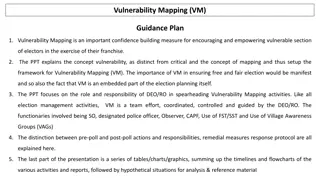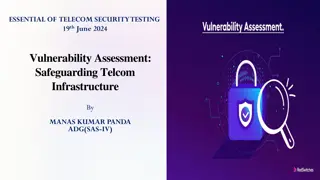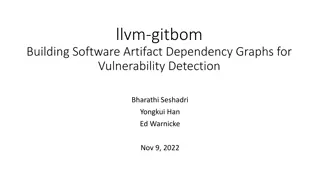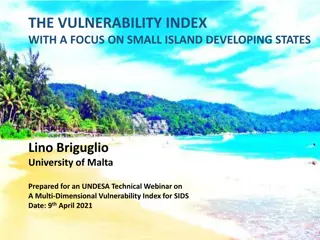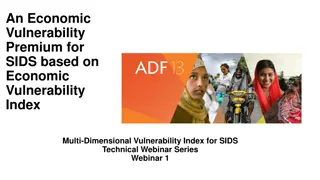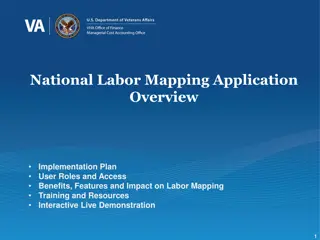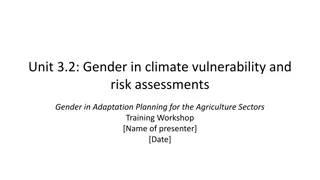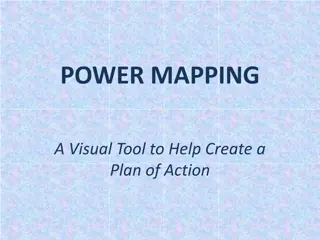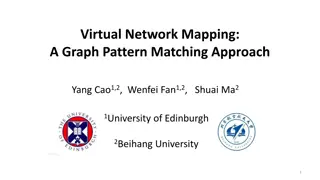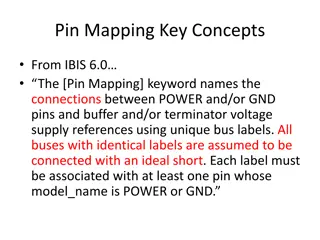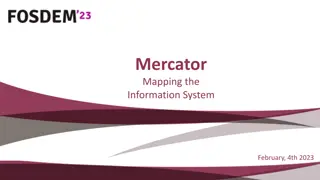Vulnerability Mapping (VM).Guidance Plan
Vulnerability Mapping (VM) is crucial in empowering vulnerable voters by identifying and addressing potential threats to their exercise of franchise. This guide explains the concept of vulnerability mapping, its role in ensuring free and fair elections, and the responsibilities of election officials in spearheading such activities. It emphasizes the need for proactive measures to safeguard voters from intimidation and undue influence, presenting a framework for conducting VM effectively.
Download Presentation

Please find below an Image/Link to download the presentation.
The content on the website is provided AS IS for your information and personal use only. It may not be sold, licensed, or shared on other websites without obtaining consent from the author. Download presentation by click this link. If you encounter any issues during the download, it is possible that the publisher has removed the file from their server.
E N D
Presentation Transcript
Vulnerability Mapping (VM) Guidance Plan 1. Vulnerability Mapping is an important confidence building measure for encouraging and empowering vulnerable section of electors in the exercise of their franchise. 2. The PPT explains the concept vulnerability, as distinct from critical and the concept of mapping and thus setup the framework for Vulnerability Mapping (VM). The importance of VM in ensuring free and fair election would be manifest and so also the fact that VM is an embedded part of the election planning itself. 3. The PPT focuses on the role and responsibility of DEO/RO in spearheading Vulnerability Mapping activities. Like all election management activities, VM is a team effort, coordinated, controlled and guided by the DEO/RO. The functionaries involved being SO, designated police officer, Observer, CAPF, Use of FST/SST and Use of Village Awareness Groups (VAGs) 4. The distinction between pre-poll and post-poll actions and responsibilities, remedial measures response protocol are all explained here. 5. The last part of the presentation is a series of tables/charts/graphics, summing up the timelines and flowcharts of the various activities and reports, followed by hypothetical situations for analysis & reference material
Part A Concept of Vulnerability Mapping (VM)
Concept of VM Introduced as a tool to curb muscle and money power though threat and intimidation for voters and to create secured environment for electors especially belonging to minority communities and economically weaker society to access the polling stations without being obstructed or being unduly influenced or intimidated by anybody to exercise the franchise with any fear or favors.
Understanding vulnerability VM Susceptibility-intimidation-undue influence-force on the voter: Susceptibility of any voter or section of voters, whether or not living in a geographically identifiable area, to be wrongfully prevented from or influenced upon in relation to the exercise of his or her right to vote in a free and fair manner, through intimidation or use of any kind of undue influence or force on the voter Contd
Understanding vulnerability contd. Objective: Objective of the Vulnerability Mapping in the context of elections is to identify such voters or sections of voters who are vulnerable or likely to be vulnerable, the persons or other factors causing such vulnerability and taking adequate corrective measures well in advance based on such identification. Contd
Understanding vulnerability contd. Confidential/dynamic report of vulnerable areas of the constituency: Listing and marking vulnerable areas/Pockets/ Villages/Polling Station on the constituency map and including in the DEMP. The report is confidential and dynamic
Legal Framework S 171C IPC: Undue Influence at Elections- Whoever voluntarily interferes or attempts to interfere with the free exercise of any electoral right commits the offence of undue influence at an election. S 123(2) RPA 1951: Any direct or indirect interference or attempt to interfere on the part of the candidate or his agent, or of any other person with the consent of the candidate or his election agent with the free exercise of any electoral right is a Corrupt Practice. S 171B(1) IPC: Whoever gives a gratification to any person to exercise any electoral right, accepts any gratification , commits the offence of bribery. Additionally, various other related provisions of IPC can be invoked by the enforcement agencies depending upon the offences those create vulnerability
Instruction on VM As stated the concept of VM was initiated in year of 2007 taking due cognizance of the role being played by the muscle power in elections and taking into account certain prevailing socio-economic realities of electoral politics. A number of instructions were issued in this regard from time to time. Now, the Commission has issued a consolidated instruction No. 464/L&O/2023/ EPS(VM) dated 21.06.2023 on Vulnerability Mapping, Critical Polling Stations and preventive measures.
Stages of VM The VM exercise takes place in three stages: Identification of the voter s/voter segments, village/hamlets/ area wise vulnerable to threat or undue influence Identification of the persons causing such vulnerability using muscle/ money power Initiating preventive measures against the persons responsible for causing vulnerability.
Vulnerable vs Critical Difference/relation between vulnerable areas and critical areas: Vulnerable Critical Specified in instruction dated 21st June 2023 Criteria explained in the same instruction For Voters/Segment etc. For polling station Pro-active Pre poll exercise to check muscle power Based on last election and current situation against weaker section of voters (Element of (Objective) Subjectivity) NB: The polling stations having vulnerable pockets are treated as critical P.S.
Parameters of VM VM-1(Annexure-1) in the instruction dated 21.06.2023 provides a set of parameters to collect the input on Vulnerability Mapping and DEO should collect such information at least six months before the date of poll fixed for the last held General Election from RO/SDM of each Assembly segment and continue updating it. Pre-Poll Complaints- (a) MCC including the misuse of money power to bribe voters in cash/kind (b) Political rivalry of diverse nature Act of political parties (Violations of MCC) Cases of defacement of private properties especially in rule area Contd
Parameters of VM contd. Inputs from the worry lists by Political parties/candidates Information sharing from the voters ( Through call centers/control room, demography composition, voting % in previous elections) to understand factors leading to VM Inputs from District intelligence branch of the district police In order to ensure authenticity of vulnerability reporting, a mechanism of collecting, cross verifying, validating and collating information at a relatively higher administration/police level to be ensured
Part B Administrative setup and responsibilities
Administrative setup and responsibilities down the line Entire responsibility with DEO/SP/RO: o Appointment of SO & Sector Police Officers o Training of SO & Sector Police Officers o Preparation of action plan
Appointment of Sector Officers One SO is to be appointed 4(four) months before the date of poll of last held election to supervise 10 to 12 PSs that can be covered in 1 to 2 hours Since this is one of the most responsible positions, so the best officers are to be identified, better if experienced & conversant of the area. Central Govt. officers can be deployed. Should be equipped with vehicle, fuel, mobile phone, ID cards etc. Shall be designated as Sector/Zonal Magistrates at least 7 days before the poll day.
Sector/designated police officer Designated Police Official for VM to work in coordination with SO Police Official at Thana level: Not below the rank of Assistant Sub- Inspector or Head Constable of police. Conduct joint exercise of VM with SO Tracking the individual trouble mongers ensuring that trouble makers are kept under watch Designated Police Officer at Thana (Police Station) Level for VM and ensuring Law and Order and peaceful poll.
Training of SO/ designated police officers Training supporting material/past record for guidance - Train jointly and provide following- E-rolls of concerned P.Ss with hamlet name etc. i. PS wise AMF details ii. Voter turn out(last election) iii. Gender Ratio iv. Route map v. MCC violation cases( last two election) vi. vii. Other details as per VM-1 Contd
Part C Pre-poll and Poll day responsibilities
Pre-poll and Poll day responsibilities roles & functions DEO/RO/SP Use of FST/SST SO Use of Village Awareness Groups (VAGs) Designated Police Officer Utilization of other revenue and Observer magisterial staff of the district CAPF Reporting formats and frequencies
Pre-poll responsibilities of DEO/RO 1. When to Start- 6 Months before the date of poll fixed for the last held G.E 2. What to do - I. Appointment letters and Identity Cards to SOs II. Training- First training immediately after the appointment Second training after the announcement of election (Due to replacements) III. Procuring Inputs and providing them as per VM-I IV. Providing copies of VM manual and Handbook and Checklist for Sector Officers V. Conferment of the powers of special executive magistrate to SO. VI. Handing over the details of VM polling station wise and list of Critical PSs to Observers by DEO/RO on their arrival.
Pre-poll responsibilities - SO - VM related Identifying physical Infrastructure/accessibility of constituency areas identification of pockets/persons - Frequent visits ( minimum three) in sector for confidence building measures and fine tuning the VM Initiating the VM exercise as per the timeline. Checking the status of accessibility and Terrain/Road condition of the sector(PS wise) for inclusion in DEMP also. Checking the status of the network accessibility of respective Telecom service providers(PS-wise) for inclusion in DEMP also. Identification of vulnerable village and hamlets/segments and voters vulnerable to threat and intimidation. Identification of persons who make it vulnerable (Report in VM- 2 & 3). Identification of electors in terms of vulnerability To act as Sector/ Zonal Magistrate accompanied by police officer. prepare a Sector/Zonal Magistrate Plan. To ensure free access of voters to voting Contd
Pre-poll responsibilities - SO - VM related contd. Techniques employed to create VM Report confidence-building measures confidentiality of informers: Have details of and meetings with - o Contact person, source within the vulnerable community o Labour Inspector and food and supply officers for identification of vulnerable areas. o Heads of educational institution, specially residential institutions. o Factory godown owners o Persons running printing press o RWAs, Gram Pradhan, Sarpanch for confidence building. Prepare list PS wise with name of village, hamlet, potential troublemakers, their address, and so on. Maintain complete confidentiality of the informers/source. Knowledge about geography of PS/Area and identify distribution of electors in term of caste, creed and religion. After the visit timely submit reports in VM 2 & 3
Poll day responsibilities: SoP frequent visit to vulnerable pockets - remain alert to complaints use FSTs Frequent check whether the vulnerable sections identified earlier are voting or not. I. In case of receiving alarming messages; RO and district administration be informed II. immediately. III. To keep a check on vulnerable sections with the help of FSTs. (Subject to change as per local sensitivities, DEO/RO may add more activities for the purpose of VM) Contd
Poll day responsibilities - Role of DEO/RO/SP Dealing with trouble mongers joint visits to locations - preventive detention confiscation of arms DEO/RO/SP- Names and contact details of persons within vulnerable group. DEO/SP- Prepare a focused action plan to deal with- o Bounding down identified trouble mongers o Confiscation of arms o Preventive detention ( with the help of VM-4 report) o Appearance in local police station/police pickets o Placement of police pickets o Special focus on P-72 hours o Action against EPIC snatching, depositing of EPIC for payment etc. DEO/SP, RO/DySP, SDM/Tehsildar/Police Inspector- joint visits/rounds on such locations and meet the communities for confidence building. DEO/RO/SP shall also interact with candidates/political parties. RO is to brief PrO about vulnerable locations at time of dispatch of Polling parties. Adequate security to be ensured on the day of poll. Contd
Poll day responsibilities - role of DEO/RO/SP contd. Measures to gather inputs and take corrective actions to diffuse vulnerability: Take regular feedback on each subject from District Intelligence(L.I.B) Deploy dedicated police teams in vulnerable pockets to locate voters at convenient places for fast movement on poll day (shall be included in District Security Plan). Form Village Level/ Ward Level Awareness Groups(VAGs/WAGs) to gather information of vulnerability and do confidence building. Ensure 24 hours surveillance by FSTs, SSTs, VVTs. Undertake required SVEEP measures and ethical voting awareness. Awareness about c-VIGIL and voter helpline number 1950 Measures are to be undertaken in non-partisan manner
Poll day responsibilities - role of CAPF DEO to provide list of vulnerable locations to Commanders/Assistant Commanders of the CAPF Special attention to be given to such locations while doing area domination by CAPF On day of poll, Commanders/Assistant Commander of CAPFs shall make a visit to such vulnerable pockets as a confidence building measure. Area Domination & Flag March. CAPFs may be deployed at the PSs where there were incidences of EVM broken/looted in the past. To immediately report to RO/DEO/SP/Observer/Sector Officer if any obstructions. Special focus on Expenditure sensitive pockets for effective check on distribution of freebies.
Poll day responsibilities - role of Observer Action by observer visit vulnerable locations constant monitoring: DEO/RO shall hand over the details of polling station-wise Vulnerability Mapping of Constituency to the Observer and list of critical P.S for approval. The Observer shall visit vulnerable locations and interact with the voters. The Observer shall constantly monitor the development and make a mention in his report.
Poll day responsibilities - poll day monitoring contd. Measures to tackle vulnerability on real-time basis on poll day visit at least twice adequate security deployment: Briefing to presiding officers by RO at dispatch center SO report to RO of low % turnout at vulnerable PS Sector Magistrate/Mobile Forces visit at least twice Visit by Observer and Senior Officers Police patrolling to keep track, police pickets if needed CAPF Commanders visit- if any obstruction report to RO/DEO/SP. Adequate security deployment
Part D Post poll responsibilities
Post poll responsibilities - monitoring after the poll Post-poll stocktaking of vulnerability/intimidation: DEO/RO is to take inputs on intimidation/threat/ obstruction Observer to pay full attention to the issue of VM and verify it at every stage Proper analysis of Form-17 A and Marked copy of Electoral Roll during scrutiny to be done by Observer.
Post poll responsibilities - accountability and confidentiality Need to maintain confidentiality regarding details of VM/sources of information security deployment details not to go in public domain: Accountability of various civil and police officials for Vulnerability Mapping of each polling station/constituency. No press conference/furnishing of details of VM, Vulnerable areas, hamlets, troublemakers & the sources of information or deployment of security forces in public domain. VM portion of DEMP- to be shared with concerned officials as separate handout Severe disciplinary action for dereliction of duty.
Part E Reports and timelines
Reports flowcharts Sl No Format Subject Matter Sender/Receiver Timeline Information on election offences, MCC violations, seizures, re-poll, voter turnout in past elections, pre poll complaints, etc. 6 months before the date of poll of last election 1 VM- I DEO SO For determining vulnerability by SO( PS wise) Submit within 3 days of announcement of election 2 VM -2 (SO) SO RO Summary of PS wise enlisting of vulnerable localities/pockets/voter segments and of intimidators by SO Submit within 3 days of announcement of election 3 VM-3 (SO) SO RO Contd
Reports Flowchart contd. Sl No Format Subject Matter Sender/Receiver Timeline Summary of vulnerability and list of persons causing vulnerability by RO RO DEO Submit within 5 days of announcement of election 4 VM-4(RO) Report on identification of vulnerability and action taken at district level ( district wise) DEO CEO Submit within 7 days of announcement of election 5 VM-5 (DEO) Report on Vulnerability mapping of the state CEO ECI submit within 10 days 6 VM-6 (CEO)
Timeline for VM S. No. Activity Time-limit Collection & compilation of basic information on each AC by DEO as per Six months before the date of poll of 1. Annexure-I from RO/SDM of each assembly segments the last election 2. Updation of basic information by DEO as per Annexure-I Before handing over to Sector Officer four months before the date of poll of 3. Appointment of Sector Officers & Police Sector Officers the last election four months before the date of poll of 4. Appointment of Sector Police Officer at police station level the last election Training of Sector Officers & Sector Police Officers & handling over of basic Four months before the date of 5. information of AC to Sector Officers by DEO poll of the last election Four months before the date of 6. Making Law and Order Portal of State functional by ECI poll of the last election Preliminary identification and submission of VM reports of vulnerable areas/ Two months before the date of poll of 7(a) segments/villages/hamlets, persons causing such vulnerabilities etc. in the last election Annexure- II, III Contd
Timeline for VM contd. S. No. Activitiy Time-limit Final identification of vulnerable areas/ segments/ villages/hamlets, persons After the issue of Press Note by the 7(b) causing such vulnerabilities etc. in Annexure - II, III Commission and before the issue of the gazette notification. 8. Submission of all VM reports in formats (Annexure II, III) to RO. Within 3 days of announcement of elections Compilation of Sector Officers reports by RO and submission to DEO (Annexure- Within 5 days of announcement of elections 9A. IV) 9B. Compilation of VM reports of ROs by DEO & submission to CEO (Annexure-V) Within 7 days of announcement of elections Certificate of NO Vulnerable village/area in Assembly Constituency, by DEO to Within 7 days of announcement of elections 10 CEO Compilation of VM reports of DEOs and submission to ECI in VM 6(CEO) Within 10 days of announcement of 11 (Annexure-VI) elections Completion of preventive/legitimate action against the persons responsible for At least 7 days before day of poll. 12 causing vulnerability Contd
Timeline for VM contd. Sl. No. Activitiy Time-limit Plan and execute joint confidence building visits by DM/SP; SDM/ Dy 13 SP; Tehsildar/ PI in areas identified as most vulnerable. Within 2 weeks prior to poll day 14 Pre-poll area domination by CAPF At least 3-5 days before poll day. Strict vigil and monitoring of vulnerable areas/persons by 15 Observers, DEO/RO, SO, Police On the Poll Day
Part F Hypothetical Situation for analysis & Reference Material
Hypothetical situation for analysis On the poll day in a parliamentary election there is information received telephonically that some voters of a particular segment are being prevented from approaching the polling station to vote. What possible action points are suggested ? write action points in chronological order
Reading/reference material DEMP Manual (LATEST) VM-MANUAL (LATEST) VM Instruction No.464/L&O/2023/EPS(VM) dated 21.06.2023 List of Critical Polling Stations with details of issues ( Parameter for identification of critical P.S annexed in the abovementioned instruction on VM) Demographic details- Caste/Religion/Minorities Caste Matrix- Village/polling station wise Contd
Reading/reference material Contd. Election offences/Statistics and crime record in VM-I format (AC wise) Checklist and Handbook (LATEST) for Sector officers/Magistrates CrPC - Chapter10 regarding Maintenance of Public orders and tranquility Contd
Reading/reference material Contd. Manual on Vulnerability Mapping 2023 - objective criteria for identification of Critical PS PSs having vulnerable pockets and PSs located in identified vulnerable area. i. ii. PSs where polling was more than 90% and where more than 75% of votes have been polled in favour of one candidate in last election. iii. PSs where polling is less than 10% iv. PSs where Re-poll conducted owing to vitiation of poll process and electoral offences such as booth capturing, during any election for Lok Sabha or State Legislative Assembly in last five years v. PSs where any sort of violence took place on poll day leading to lodging of FIR, during any election for Lok Sabha or State Legislative Assembly in last five years. vi. PSs with higher than constituency average % of Absentee, Shifted and Dead (ASD) voters (Ref: Constituency Average % of ASD Voters=Total number of ASD Voters in the constituency/ Total number of polling station) vii. Information regarding abnormal law and order situation in any particular area.





